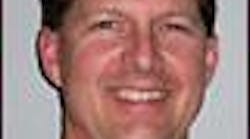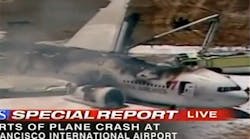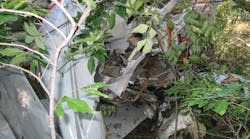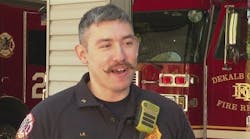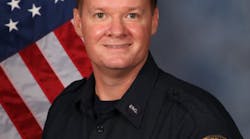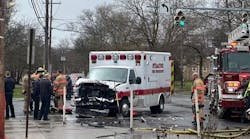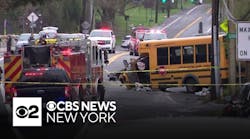July 12--When reports of Asiana Airlines Flight 214's crash-landing at San Francisco Airport started flowing over Anthony Robinson's radio, all non-fire fighting thoughts flew out of his head.
Robinson temporarily set aside the recent death of his 81-year-old father; the fact that he had taken command of San Francisco Fire Department's airport outpost as captain just four months earlier and his habit of checking in with his wife right after major incidents.
Instead, Robinson, of Vallejo, went to work.
"It's controlled chaos. You've got a plane broken in pieces on, fire; You've got people coming off the plane," Robinson said. "But you have people doing exactly what they're supposed to be doing ... I'm used to chaos, but I'm not used to a 777 (Boeing) crashing as the San Francisco Airport.... This was just another chaotic incident, but it was larger than most."
It took at least 40 minutes for the magnitude of the incident to hit home for Robinson, he said.
He did not have time for much of a reaction, being kept continuously busy from the 11:27 a.m. crash to 7 p.m., when he had his first break.
Concerns stemming from recorded 9-1-1 dispatch calls released Wednesday have focused on the sufficiency of medical response to the crash scene.
Robinson explained that, as the emergency incident commander, his job was to set the distance for emergency vehicles that would arrive soon after him.
"I parked far away from the plane, because as I positioned my unit, all other units fall in behind me," Robinson said. "No less than 30 vehicles, ambulances, fire engines, mobile units, commands, helicopters, are all parking from my point, behind me. I have to choose a safe point where everyone else is going to park."
As he took command of the scene, Robinson said his emergency units, including two rescue units, were already there and asking for more assistance for survivors.
"They were there probably in a little over a minute," Robinson said of Station 2, dubbed "crash house" because of its proximity to the runways. "They got there fast. They were there before I got there, and I got there fast."
He went to work calling for a "recipe of resources," including mutual aid backup from San Mateo County and San Francisco, shuttle buses for survivor transport from the plane area to a safe distance, and the coroner's office -- just in case.
By the time the first sweep for passengers was complete and firefighter had turned to fighting the fire, the "cavalry arrived" with backup assistance and a San Francisco Fire Department assistant chief, who took over command from Robinson, he said.
"Then, it became a triage situation, where you have over 300 people that are injured in one way or another. You divide them into categories," Robinson said, adding that the categories determine the order patients are sent to the hospital.
Training immediately useful
Less than half an hour before the plane hit the tarmac, Robinson was finishing a drill with his personnel -- bringing together all the fire engines, "ARFF" (Aircraft Rescue and Fire Fighting) units and medical staff.
"It was how to replenish the water supply on the ARFF units. The ARFF units, they shoot foam and water on the plane," Robinson said.
Foam is favored over water in the case of fuel, because it smothers, rather than spreads, flames carried on top of the water, Robinson said.
That drill would come in handy almost immediately, because firefighter were now aware of how long it took for the ARFF vehicles to run out of water.
Not long after the drill concluded, Robinson was driving a command vehicle sport utility vehicle outside the fence-secured airport area, known as the Airport Operation Area, where planes taxi and runways are located.
The call for an "alert 3" -- meaning there is an imminent problem -- came over the radio. Comparatively, an alert 1 notifies firefighter to open their bay doors and is likely a call for something like low tire pressure on a landing plane, Robinson said.
"I've never heard the word 'alert 3' come over the radio," Robinson said. "I thought for sure that they just made a mistake... then, minutes later, it followed up, 'alert 3, plane crash.' "
Robinson said he was stunned. He was even more so, when he drove up to the highly-secured fence, where he and others must always provide credentials before entering.
"On this day ... I don't even get to the gate yet, and the gate is already open, the guard is already outside, he's just waiving me frantically to go. 'Go, go, go!' I'm thinking to myself, 'Oh my god,' " Robinson said.
Between a 2-mile-plus runway and giant hangers blocking his view, Robinson said it took a while to see the crash site as he was careening toward it.
Then, a plane broken into pieces, fire and smoke came into view. His ARFF units were already there, just about to begin applying foam to the plane.
The incident was so strident that all emergency responders were given free access to drive as the crow flies -- straight across runways, access normally requiring special permission.
But Robinson, after some thought, said he was glad to have been in charge for the tragedy's earliest moments.
"This is, by far, the biggest incident that I have ever seen," Robinson said. "I'm glad that I was here to experience this, because it's only going to aid me in the future and you learn from actual doing."
Contact staff writer Jessica A. York at (707) 553-6834 or [email protected]. Follow her on Twitter @JYVallejo.
Copyright 2013 - Times-Herald, Vallejo, Calif.
